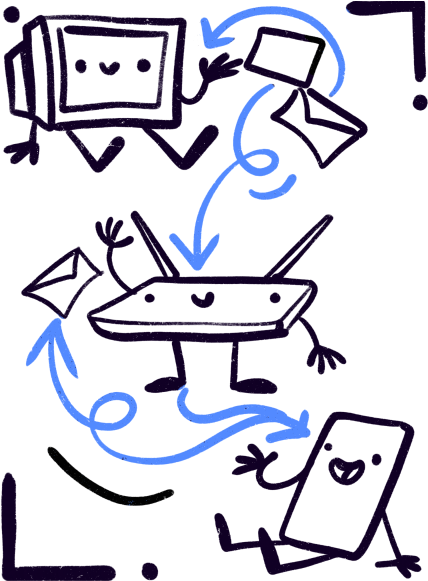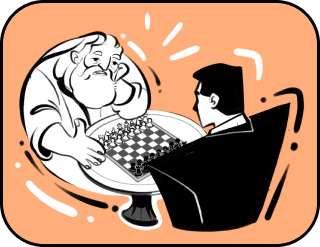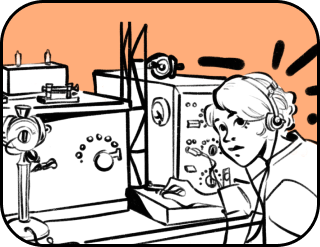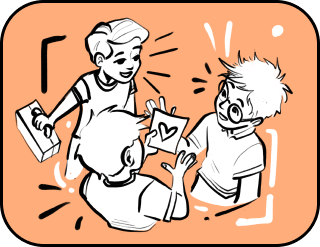Category: Cognitive technologies
The whole truth about wi-fi
“There’s only one God — but many providers”
Russian computer scientist and humorist Stas Yankovsky
Sometimes silence frightens. Not the kind you find in a library or a quiet forest at night — no, this silence is different. Darker, digital, sudden. It comes when you turn on your phone, and in the corner where the signal icon usually glows — there’s nothing. No bars. No signal. The phone searches the air, but the air is empty. No messages. No news. Not a single notification. Everything else seems to work, and life flows as usual, yet something feels off. A bridge that once connected you to the outside world has crumbled.
You peek under the table, check the socket, reboot the router over and over again. You wait. The silence stretches on. And then a strange thought creeps in: “It was alive. It answered me.” It means your unseen ally, stranger, magical spirit dwelling in your home.
Its name is Wi-Fi. You don’t remember when it arrived, but you remember how it changed everything. No more dragging cables, no more sitting close to the socket. The air itself became a conductor. It brought you knowledge, music, and the voices of loved ones. Space filled with movement, your home soaked in connection — alive, invisible, constant. You sit by the window, holding the router like an ancient artifact, and ask: “Where did you come from, spirit of the signal? How do you work? And why have you vanished?”
The Legend of How Wireless Connection Appeared
“When wireless is perfectly applied the whole earth will be converted into a huge brain, which in fact it is, all things being particles of a real and rhythmic whole. We shall be able to communicate with one another instantly, irrespective of distance”
Nikola Tesla
Long ago, in the era of cables and cords, the internet was tethered to the wall like a household pet on a short leash. People stretched toward sockets, sitting on the floor near bulky boxes — those very boxes called modems, which turned the telephone signals traveling through wires into the internet. Their computers, laptops, and gaming consoles were moored like boats, unable to drift further than the length of the cable. Back then, few believed the air itself could ever become a road — wide, fast, infinite — carrying signals without any strings attached.
But there were those who believed. Who dreamed.
The names of these people rarely echo in history lessons. Yet they were the wizards of silicon and copper who began to tame the air. Radio waves, long used for military communication, televisions, and radars, suddenly turned out to be capable of carrying the internet too. They just had to be taught how.
In 1997, the first scroll appeared, opening the path to mastering wireless connection. Its name was strange — 802.11. Not a spell or a poem, but a dry code adopted by a council of elders called the IEEE — the Institute of Electrical and Electronics Engineers. They named their creations with numbers: 802 was a whole realm of knowledge about networks, and the .11 pointed the way to wireless connection.

This was the first language in which the air began to understand us. In ancient myths, humans once tamed fire; now, they began to tame connection. And the air obeyed: first timidly, with hiss and interference, then more confidently. Radio waves gained the power to carry not just sound, but information.
Among those who forged this invention were Vic Hayes — the father of Wi-Fi, who led the creation of the first wireless standard IEEE 802.11; John O’Sullivan, whose work in Australia on radio signals for telescopes helped create data transmission technology over the air; and Hedy Lamarr, actress and inventor, whose ideas about frequency hopping laid the groundwork for wireless communication.
Once connection became obedient, people realized that a standard alone wasn’t enough — a symbol was needed. A name that millions would love. And so Wi-Fi was born.
There is no real meaning like “Wireless Fidelity” — that’s just a myth people try to pass off with an air of authority. It’s simply a marketing team brought in by the electronics institute who decided the name should sound like Hi-Fi, a word already carrying a sense of quality, technology, and style.
Hi-Fi (High Fidelity) — a term from the world of audio technology. It meant high precision in sound transmission. People had already come to trust that Hi-Fi was a seal of quality. Wi-Fi was meant to evoke the same feeling. So the marketers didn’t invent a complicated formula — they invented a feeling: a name easy to say, and a logo easy to remember.
With each passing year, Wi-Fi grew stronger. Behind the letters 802.11b, g, n, ac, ax hid progress, speed, stability, and range. Wi-Fi was learning to understand us better, to carry more data, to respond faster.
The protocol 802.11b (1999) was the first to bring Wi-Fi into homes — slow, uncertain, but alive.
The protocol 802.11g (2003) sped up the data flow.
The protocol 802.11n (2009) learned to fly on two waves at once — 2.4 GHz and 5 GHz — as if it had grown two wings.
The protocol 802.11ac (2013) helped Wi-Fi soar like a jet arrow.
The protocol 802.11ax (2019), known as Wi-Fi 6, became ten times smarter and faster than its predecessors. It mastered the art of efficiently sharing connections among many devices and boosting energy efficiency.
The signal began to fly through walls: it became an invisible bridge, linking your phone in the bedroom with a distant server somewhere on the edge of the Earth. It became a web without threads, a conductor without wires, a connection without knots. It tamed the air. And in that lay the first victory.

Once upon a time, there was a little box named Modem. He spoke two languages: the language of machines and the language of telephone lines. When a computer asked him to fetch something from a distant world — a picture, a letter, music — Modem sent that request through the wires, turning numbers into sounds.
The telephone line listened, though it didn’t understand everything. And when the response came back, Modem caught it, tuning in to every beep and click, transforming it again into a language the computer could understand.
So, between the two worlds — a digital and an analog one — lived and worked a humble translator. And though his voice was strange and creaky, it carried the very first true internet.
How the Creature Called Wi-Fi Works
Wi-Fi is a spirit, a helper living in the air — between the human world and the world of devices. Wi-Fi is waves, countless waves, invisible to the human eye. These waves hear everything and know everything. They carry information, and each signal bears an infinite amount of data.
If you listen closely, you can hear the spirit singing in the 2.4 GHz range. It moves unhurriedly. It seeps through walls, doors, heavy concrete slabs, overcoming obstacles, but because of that, its speed sometimes slows to cross great distances.
In the 5 GHz range, the spirit rushes swiftly, yet it still fears walls. Like a young warrior, it pushes forward, but its inexperience makes it vulnerable to any barrier.
Routers command this process and decide where each signal should go. They know when and how to direct the flow of waves so the connection stays steady and the whole world remains connected.
Once upon a time, there were tiny but very fast creatures — the gigahertz. There were many of them, and each could run a circle in one billionth of a second.
Every morning, they would get up and run in circles millions, billions of times. But they didn’t run for nothing. With every circle, they sent a message. One lap — one command. One turn — one piece of information.
When someone pressed a button on their phone, deep inside the router, the gigahertz would start running. One would say, “They pressed it!” and pass the command to the next gigahertz. Another ran to the screen and whispered, “Time to light up!” A third hurried to the antenna: “Send this through the air!”
The faster the gigahertz ran, the quicker websites opened, games launched, and music played.
But if there were too few of them, or if they ran slowly, the whole world would freeze and wait.
Watching over the gigahertz was the Router. It was inconspicuous, standing quietly in a corner with its little antenna horns, not attracting attention. But all the work in the house depended on it.
Every morning, the gigahertz flocked to the router. They chirped and carried letters, movies, music, and even calls from faraway lands. The unflappable Router waved its antennas: “You — to the laptop! You — to the TV! And you, fly to the phone, it’s waiting for a message from a friend!”
Sometimes, walls appeared — the troublemakers — blocking the waves from passing through. Sometimes, old devices were brought in, ones that didn’t understand the new language of signals. Then the Router would start to work its magic: retuning frequencies, finding new routes so that not a single bit of precious information would be lost.
It was the invisible guardian of connection. And though no one thanked it, it knew that as long as it worked, the house breathed internet, and all its inhabitants were tied together by a single thread.

Router Setup. The Ritual of Summoning.
A fresh, just-bought router arrives at its new home. It’s not yet alive in the world of Wi-Fi, but in your hands, it can awaken. Setting up the router is like the moment of awakening — when you open the gates between worlds.
You plug the router into power — a light flickers on. A tiny “eye” wakes up, and the device begins to “breathe.” But it’s still silent, not yet speaking to the world. The gates are not yet open.
You take your laptop or phone and search for the network. The first test — finding the name. It might be strange: “TP-LINK\_872A,” “NETGEAR34,” “ASUS\_5G.” You connect and step inside.
In your browser, you open a portal: you enter 192.168.0.1 or 192.168.1.1. This is the gateway to the interface world. The page appears like an ancient scroll with empty fields: “login” and “password.”
You enter the default keys — Login: admin; Password: admin, or Login: admin; Password: 1234, or 0000 — words known to all. If you’re cautious and understand the value of privacy, you change them right away. Because the “summoner’s” name should not be known to every passerby.

Now you’re inside. The control panel lies in front of you. Here you choose a name for your network. Next, you create a password that will guard the entrance to your digital realm.
Never leave the network open — for a spirit without protection becomes prey. Invent a strong key, with letters, symbols, and numbers. Only you and those who know this key may enter the digital reality.
Now you select the frequency: 2.4 GHz — the old wave, long-reaching but noisy; 5 GHz — fast and clean, but capricious. And if you’re lucky, the owner of a dual-band router with four antennas, then inside one plastic shell you have both the “sage” (2.4 GHz) and the “young whirlwind” (5 GHz) working together.
Now you press the “Save” button. The router blinks. A little window flashes. One moment — and the silence in the house fills with the whisper of connection.
You feel it has awakened.
You have just summoned to life a creature that will connect you to the whole world.
You have become its master.
And now the air is filled with digital life.
All thanks to the ritual you performed correctly.
Mistakes of the Summoners — Or How Not to Scare Away the Spirit of Connection
Not everyone who calls upon the spirit of connection does it right. Not every one who once awakened Wi-Fi knows how to handle it gently and wisely. Sometimes the magic falters because of the summoner’s own mistakes.
1. You placed the router where it doesn’t belong: under the table, behind the radiator, inside a closet, or in the hallway where drafts blow and the cat plays.
This is not a place of power. Wi-Fi loves height and openness. It needs the heart of the home — a spot with clear sightlines, from where its waves can spread like a song carried by the wind. Hide the router far away — and the spirit will take offense. It will grow moody, and the signal will start to vanish.
2. The password “12345678” is like a door with a sign that says, “Come in, anyone.”
A true protector ties the password to strength: complex, long, and unpredictable. The password is the shield.
3. You choose only the 5 GHz band because you heard it speeds up video streaming with perfect quality.
But if your walls are thick, made of concrete like an ancient fortress, Wi-Fi in this band will get lost. It’s fast but fragile — such barriers sap its power.
4. You set up Wi-Fi once and then forget about it: no firmware updates, no checking the list of connected devices, no clearing the clutter.
Don’t do that. It’s like building a tower and ignoring the cracks that slowly spread.
The ritual demands care. Everyone makes mistakes, but one thing is certain — the Wi-Fi spirit does not forgive disorder.
5. You connect every device to Wi-Fi: TV, smartphones, tablets, laptops, fridge, and even the robot vacuum.
The router starts to lose focus. Too many spells, and each signal struggles to find its path. Don’t overload the wizard.
When everything is set, cleaned, and arranged with respect and knowledge, you sit again by the window.
The invisible spirit of the signal settles nearby.
It sings.
It flies through the air.

The Union that Holds the World
“It will soon be possible to transmit wireless messages around the world so simply that any individual can carry and operate his own apparatus”
Nikola Tesla
Around us, there is silence — but within it, a song is playing. We don’t hear it with our ears, yet it carries the voices of loved ones, knowledge, music, and support. This song is called Wi-Fi.
Wi-Fi has become more than just a signal. Now it is like a sturdy fabric woven into the everyday. We wake up with Wi-Fi, work, communicate, grow — and all this time, it is there beside us. It asks for no thanks, but it deserves them.
Wi-Fi connects people, ideas, entire continents. And every time you see that familiar icon at the top of your screen, know this: it’s not just convenience. It’s a piece of magic you have tamed. A part of the world you hold in your hands.
We illuminate scientific horizons with an intensity that rivals a laser.
Thank you!




